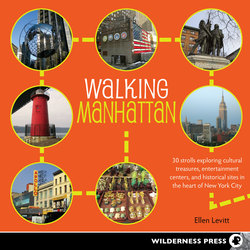Читать книгу Walking Manhattan - Ellen Levitt - Страница 9
На сайте Литреса книга снята с продажи.
ОглавлениеINTRODUCTION
LET’S FACE IT: When people think of New York City, most often they’re thinking of Manhattan, the most densely populated of the five boroughs that constitute this city. As a lifelong resident of Brooklyn, I bow my head in deference to Manhattan as the capital, the lifeline, the cultural core, the economic engine overall.
The Lenape Indians referred to this long, thin piece of land as Manna-hata, or “island of many hills.” During colonial times, the Dutch and then the British had control over Manhattan. Some parts sustained much damage during the American Revolution, but once the war for independence was won, New York became the first capital of the nation.
Through the years, Manhattan has been a center of commerce and finance, education and scholarship, entertainment and culture, innovation and research. It has seen destruction in the form of fires, terrorist attacks, storms, power outages, looting, and accidents of many types—car, rail, and construction among them. Meanwhile, the infrastructure of Manhattan is astounding: from bridges to alleys, skyscrapers to pop-up shops, along with commercial and residential edifices, religious and educational sites, parks and playgrounds. Automobiles, buses, trains, boats, and helicopters arrive and depart daily (but not airplanes; the nearest airports are in Queens and New Jersey).
Some walking advice:
Wherever you go, don’t be scared—but do be aware of your surroundings, as well as the time of day.
It’s always helpful to carry certain items, such as a pack of tissues (in case a bathroom stall is out of paper), a pen, a piece of identification, a small umbrella, and a few bandages (you’d be surprised how often you might need these).
Stay alert to traffic, be it cars and trucks, bikes and strollers, workers with deliveries, or distracted pedestrians. Some New Yorkers jaywalk; if you do, be very careful—and don’t assume that everyone obeys traffic lights and the right-of-way.
Use landmarks to visually orient yourself. Skyscrapers like the Empire State Building are excellent for this.
When you need a bathroom, among the best places to look for decent, accessible facilities are department stores, libraries, large houses of worship that are open, and hotels. If you’re visiting a museum or touristy site and it has a bathroom, you might want to use it while you’re there. Other places to find restrooms, although they may not be as pleasant, are parks, certain major subway stations, and portable johns in various locations.
Look out for broken pavement, construction hazards, dog or horse messes, and other conditions on sidewalks and roads that could cause accidents or unfortunate situations.
If the street musicians you pass are at least pretty good, give them some coins (or more, if you’re feeling generous).
It may seem that every other New Yorker is preoccupied by a cell phone or handheld device, but you don’t want to do that. To experience Manhattan, you need to see, hear, and smell things.
Have a good time, a meaningful time, a memorable time walking Manhattan!
Manhattan’s outdoor sculptures—such as Noguchi’s The Cube—can amuse and inspire.
